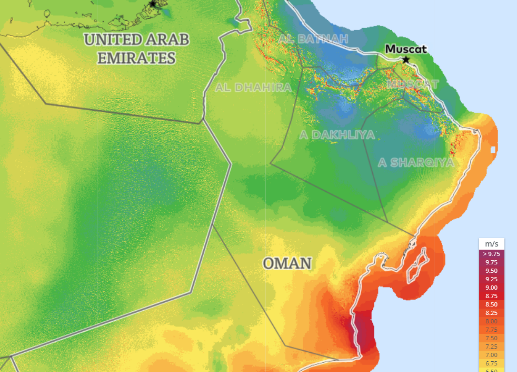A study conducted by researchers of the Department of Geography, College of Arts and Social Sciences at Sultan Qaboos University (SQU) has found that both solar radiation and wind are promising and substantial renewable energy alternatives to fossil fuel resources in Oman.
The study entitled, ‘Exploring the potential of solar, tidal, and wind energy resources in Oman using an integrated climatic-socioeconomic approach’, was published recently by ScienceDirect, a leading platform of peer-reviewed literature and a website which provides subscription-based access to a large database of scientific and medical research.
According to the authors, , Mohamed Hereher and Ahmed M el Kenawy, the study presents for the first time, a comprehensive assessment of the potential renewable energy resources in Oman, with a particular focus on solar, wind and tidal energy resources. The study adopts a novel approach to assess the potential of these energy resources, in which information from multiple climatic indicators is coupled with socioeconomic drivers of energy development. Specifically, based on a daily dataset of the National Centers for Environmental Prediction (NCEP) Climate Forecast System Reanalysis (CFSR), three climate indicators were employed to characterize the frequency, intensity, and duration of solar radiation and wind speed.
The authors introduced a new overall assessment index (OAI) based on these three climatic indicators to explore the best localities – from a climatic perspective-for generating solar and wind energies. The validity of the recommended sites was discussed in the context of important physiographic, environmental, and socioeconomic constraints (e.g. population density, urban settlements, distance to water bodies, transportation network, and so on).
The results demonstrate that both solar radiation and wind can be seen as promising and substantial alternative sources of fossil fuel resources in Oman, with almost 3.2 per cent and 4.4 per cent of the Omani territory being valid for sustainable use of wind and solar radiation, respectively, the authors stated.
The most recommended sites for wind generation are located mainly along Al-Jazir and Duqm coasts of southeastern Oman, where a promising wind energy center can be constructed. The best localities for the development of hybrid solar radiation generation centres are likely to be placed in Suhar and Thamrait, where solar intensity approaches 8.1?kWh/m2, with a high frequency of occurrence throughout the year.
Last year, the Oman Power and Water and Procurement Company (OPWP) — the country’s sole buyer of electricity — unveiled its renewable energy development plan which envisions the procurement of 3,050 megawatts (MW) of renewables-based capacity by 2025. The first 500 MW of this capacity will come into operation in 2021 when the Ibri II Solar Independent Power Project (IPP) is completed. By 2023, an extra 1,000 MW will be added to the portfolio when Manah Solar 1 and Manah Solar II are brought into operation. OPWP’s plan also envisions private-driven investments in wind-based projects
The study provides a solid base for national and local decisionmakers in Oman for a reliable assessment, monitoring, and sustainable exploitation of clean and renewable energy resources, especially with high population growth, accelerated urbanization, and rapid economic growth over the past few decades, which can pose more challenges to future energy demand in this country, the authors added.
Jomar Mendoza, Oman Daily Observer


